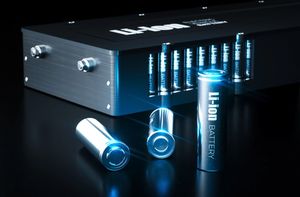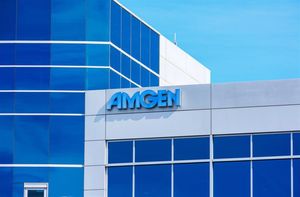
Industrial fluid and energy systems manufacturer Graham Corporation (NYSE: GHM) reported Q3 CY2025 results topping the market’s revenue expectations, with sales up 23.3% year on year to $66.03 million. The company expects the full year’s revenue to be around $230 million, close to analysts’ estimates. Its GAAP profit of $0.31 per share was 10.7% above analysts’ consensus estimates.
Is now the time to buy Graham Corporation? Find out by accessing our full research report, it’s free for active Edge members.
Graham Corporation (GHM) Q3 CY2025 Highlights:
- Revenue: $66.03 million vs analyst estimates of $57.55 million (23.3% year-on-year growth, 14.7% beat)
- EPS (GAAP): $0.31 vs analyst estimates of $0.28 (10.7% beat)
- Adjusted EBITDA: $6.30 million vs analyst estimates of $6.04 million (9.5% margin, 4.3% beat)
- The company reconfirmed its revenue guidance for the full year of $230 million at the midpoint
- EBITDA guidance for the full year is $25 million at the midpoint, above analyst estimates of $24.58 million
- Operating Margin: 6.5%, in line with the same quarter last year
- Free Cash Flow Margin: 14.3%, down from 19.5% in the same quarter last year
- Backlog: $500.1 million at quarter end
- Market Capitalization: $682 million
Graham’s President and Chief Executive Officer, Matthew J. Malone stated, “I am pleased with our performance through the first half of the fiscal year. Our team continues to execute well across all business lines, driving broad-based growth supported by a record $500.1 million backlog. Demand across our end markets remains healthy as our Defense and Space markets continue to experience robust activity, and the Energy & Process market remains resilient. These trends are underscored by approximately $14.8 million of new Space orders secured and a $25.5 million follow-on order for the MK48 Torpedo program during the quarter, reinforcing our position as a trusted partner on critical platforms.”
Company Overview
Founded when its founder patented a unique design for a vacuum system used in the sugar refining process, Graham (NYSE: GHM) provides vacuum and heat transfer equipment for the energy, petrochemical, refining, and chemical sectors.
Revenue Growth
A company’s long-term sales performance is one signal of its overall quality. Any business can put up a good quarter or two, but the best consistently grow over the long haul. Thankfully, Graham Corporation’s 19.6% annualized revenue growth over the last five years was incredible. Its growth beat the average industrials company and shows its offerings resonate with customers, a helpful starting point for our analysis.
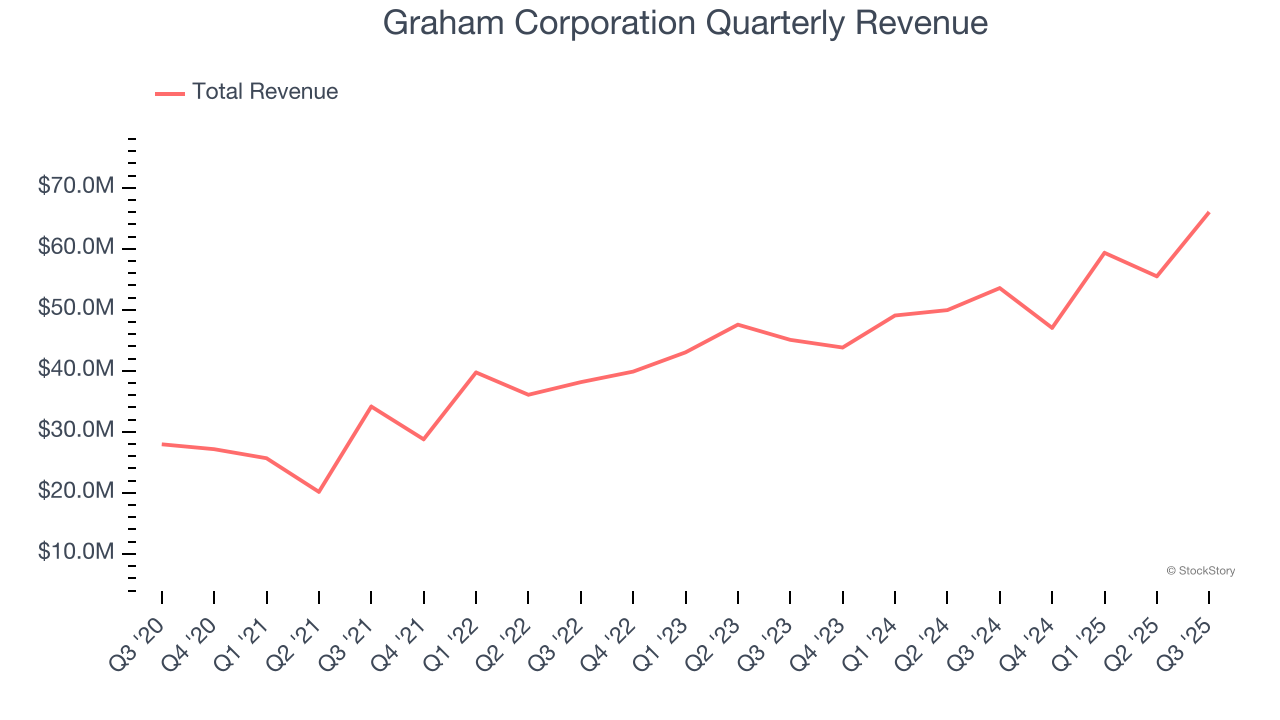
We at StockStory place the most emphasis on long-term growth, but within industrials, a half-decade historical view may miss cycles, industry trends, or a company capitalizing on catalysts such as a new contract win or a successful product line. Graham Corporation’s annualized revenue growth of 13.9% over the last two years is below its five-year trend, but we still think the results suggest healthy demand. 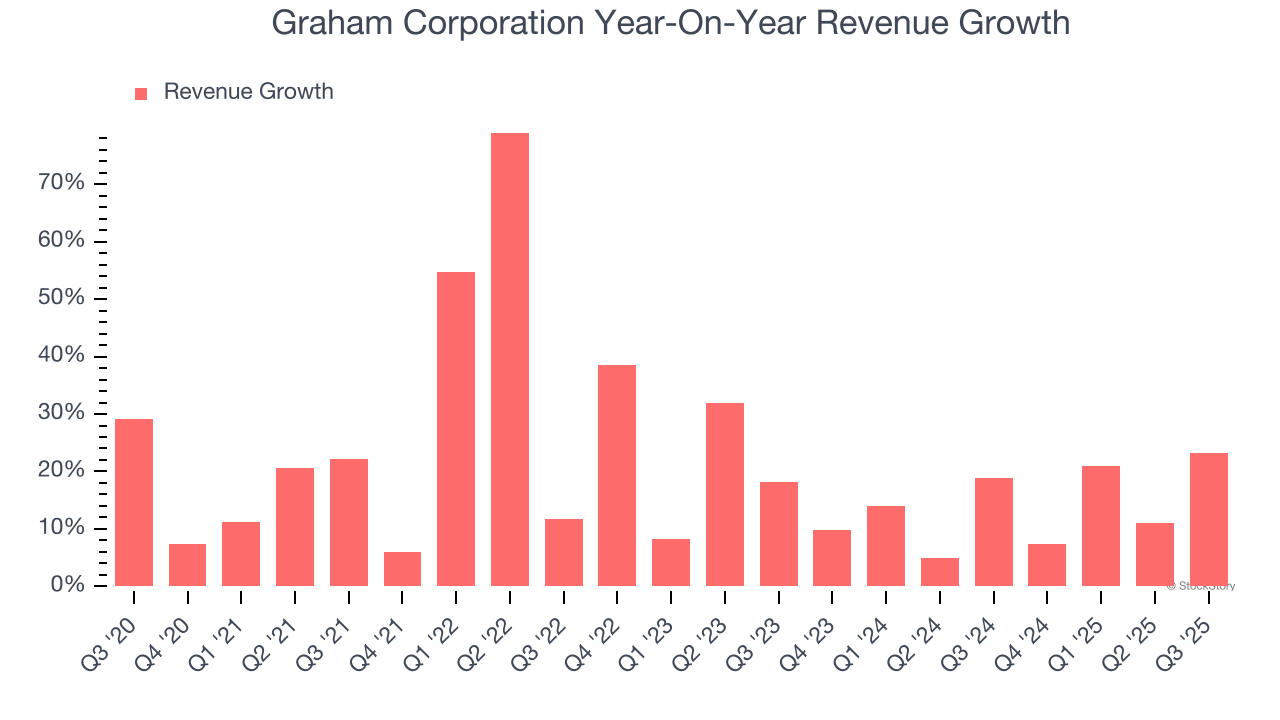
Graham Corporation also reports its backlog, or the value of its outstanding orders that have not yet been executed or delivered. Graham Corporation’s backlog reached $500.1 million in the latest quarter and averaged 21.7% year-on-year growth over the last two years. Because this number is better than its revenue growth, we can see the company accumulated more orders than it could fulfill and deferred revenue to the future. This could imply elevated demand for Graham Corporation’s products and services but raises concerns about capacity constraints. 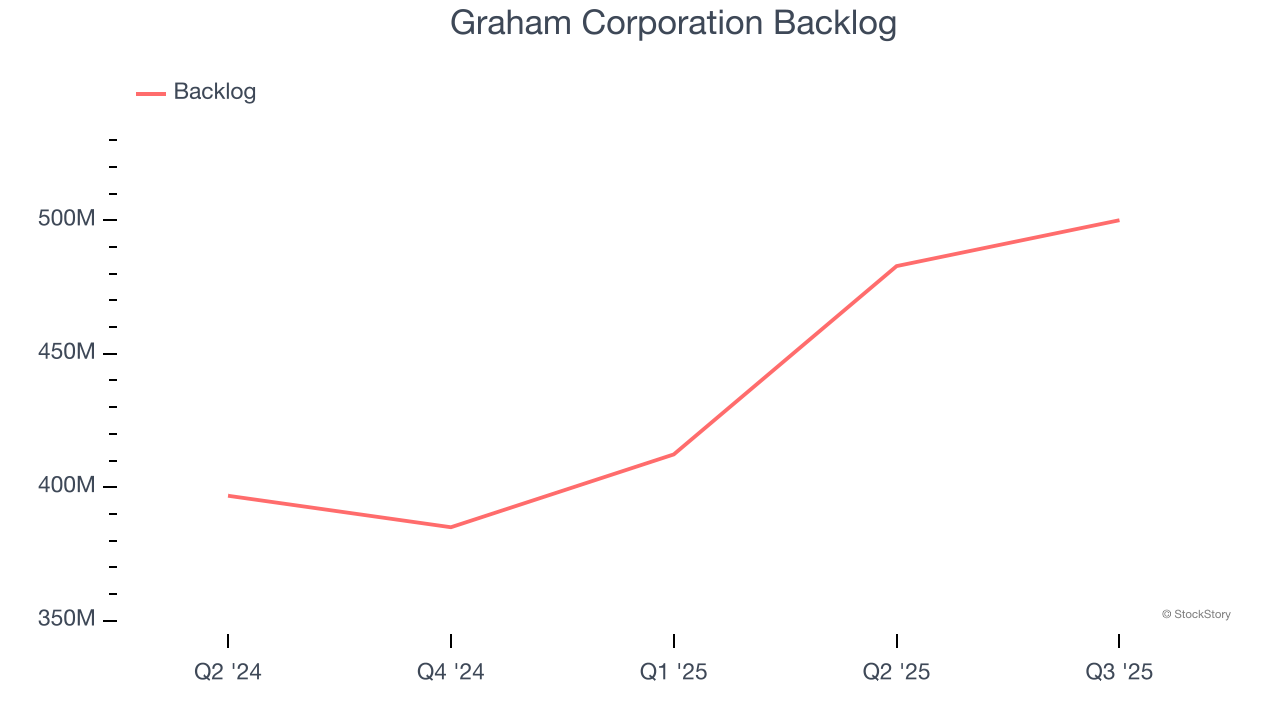
This quarter, Graham Corporation reported robust year-on-year revenue growth of 23.3%, and its $66.03 million of revenue topped Wall Street estimates by 14.7%.
Looking ahead, sell-side analysts expect revenue to grow 7.1% over the next 12 months, a deceleration versus the last two years. This projection doesn't excite us and indicates its products and services will see some demand headwinds. At least the company is tracking well in other measures of financial health.
The 1999 book Gorilla Game predicted Microsoft and Apple would dominate tech before it happened. Its thesis? Identify the platform winners early. Today, enterprise software companies embedding generative AI are becoming the new gorillas. a profitable, fast-growing enterprise software stock that is already riding the automation wave and looking to catch the generative AI next.
Operating Margin
Operating margin is a key measure of profitability. Think of it as net income - the bottom line - excluding the impact of taxes and interest on debt, which are less connected to business fundamentals.
Graham Corporation was profitable over the last five years but held back by its large cost base. Its average operating margin of 2.4% was weak for an industrials business. This result isn’t too surprising given its low gross margin as a starting point.
On the plus side, Graham Corporation’s operating margin rose by 9.2 percentage points over the last five years, as its sales growth gave it immense operating leverage.
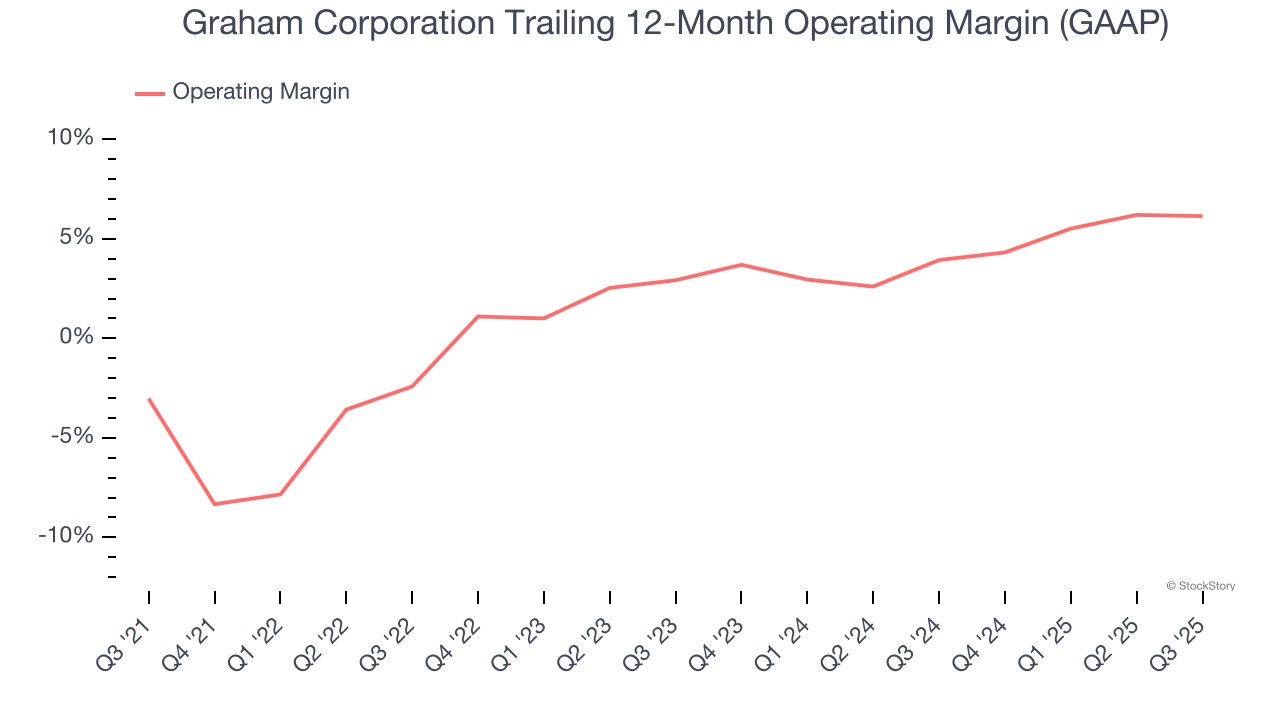
This quarter, Graham Corporation generated an operating margin profit margin of 6.5%, in line with the same quarter last year. This indicates the company’s cost structure has recently been stable.
Earnings Per Share
We track the long-term change in earnings per share (EPS) for the same reason as long-term revenue growth. Compared to revenue, however, EPS highlights whether a company’s growth is profitable.
Graham Corporation’s EPS grew at an astounding 53.3% compounded annual growth rate over the last five years, higher than its 19.6% annualized revenue growth. This tells us the company became more profitable on a per-share basis as it expanded.
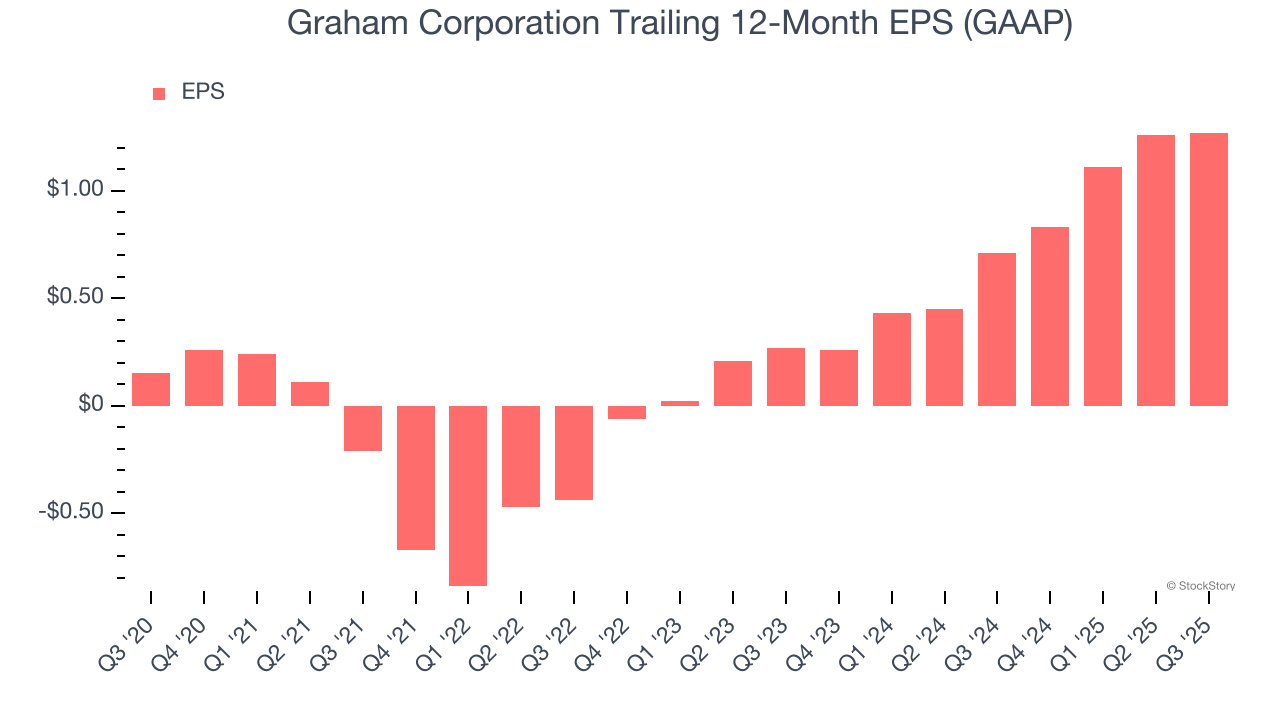
Diving into the nuances of Graham Corporation’s earnings can give us a better understanding of its performance. As we mentioned earlier, Graham Corporation’s operating margin was flat this quarter but expanded by 9.2 percentage points over the last five years. This was the most relevant factor (aside from the revenue impact) behind its higher earnings; interest expenses and taxes can also affect EPS but don’t tell us as much about a company’s fundamentals.
Like with revenue, we analyze EPS over a more recent period because it can provide insight into an emerging theme or development for the business.
For Graham Corporation, its two-year annual EPS growth of 117% was higher than its five-year trend. We love it when earnings growth accelerates, especially when it accelerates off an already high base.
In Q3, Graham Corporation reported EPS of $0.31, up from $0.30 in the same quarter last year. This print easily cleared analysts’ estimates, and shareholders should be content with the results. Over the next 12 months, Wall Street expects Graham Corporation’s full-year EPS of $1.27 to grow 3.5%.
Key Takeaways from Graham Corporation’s Q3 Results
We were impressed by how significantly Graham Corporation blew past analysts’ revenue expectations this quarter. We were also glad its EBITDA outperformed Wall Street’s estimates. Overall, we think this was a decent quarter with some key metrics above expectations. The stock remained flat at $62.14 immediately after reporting.
Big picture, is Graham Corporation a buy here and now? If you’re making that decision, you should consider the bigger picture of valuation, business qualities, as well as the latest earnings. We cover that in our actionable full research report which you can read here, it’s free for active Edge members.



